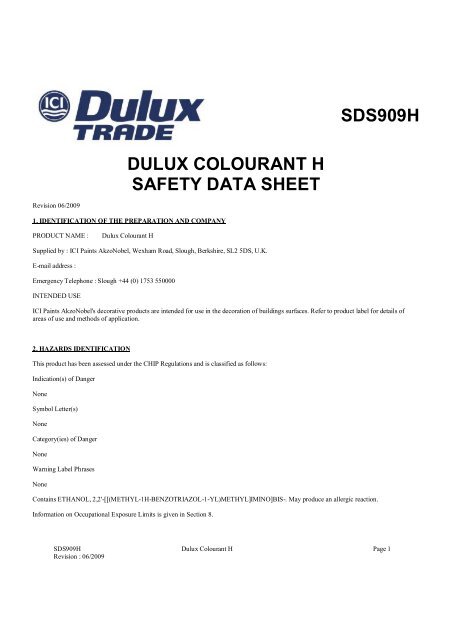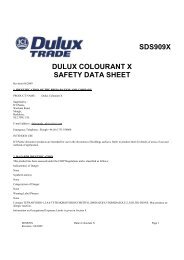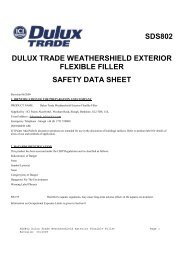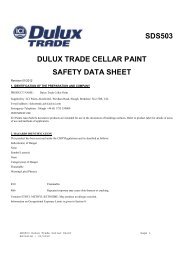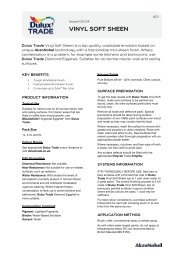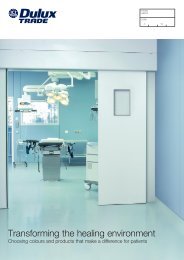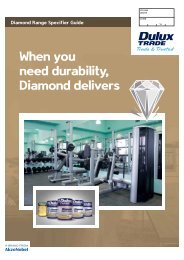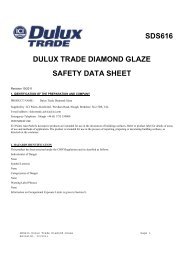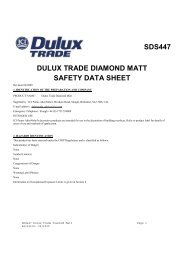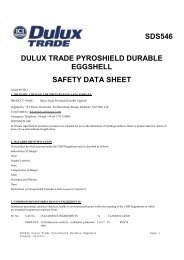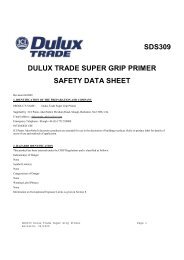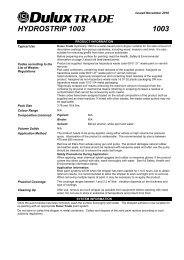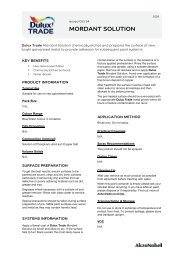SDS909H Dulux Colourant H 5 - Dulux Trade
SDS909H Dulux Colourant H 5 - Dulux Trade
SDS909H Dulux Colourant H 5 - Dulux Trade
You also want an ePaper? Increase the reach of your titles
YUMPU automatically turns print PDFs into web optimized ePapers that Google loves.
<strong>SDS909H</strong><br />
DULUX COLOURANT H<br />
SAFETY DATA SHEET<br />
Revision 06/2009<br />
1. IDENTIFICATION OF THE PREPARATION AND COMPANY<br />
PRODUCT NAME :<br />
<strong>Dulux</strong> <strong>Colourant</strong> H<br />
Supplied by : ICI Paints AkzoNobel, Wexham Road, Slough, Berkshire, SL2 5DS, U.K.<br />
E-mail address :<br />
Emergency Telephone : Slough +44 (0) 1753 550000<br />
INTENDED USE<br />
ICI Paints AkzoNobel's decorative products are intended for use in the decoration of buildings surfaces. Refer to product label for details of<br />
areas of use and methods of application.<br />
2. HAZARDS IDENTIFICATION<br />
This product has been assessed under the CHIP Regulations and is classified as follows:<br />
Indication(s) of Danger<br />
None<br />
Symbol Letter(s)<br />
None<br />
Category(ies) of Danger<br />
None<br />
Warning Label Phrases<br />
None<br />
Contains ETHANOL, 2,2'-[[(METHYL-1H-BENZOTRIAZOL-1-YL)METHYL]IMINO]BIS-. May produce an allergic reaction.<br />
Information on Occupational Exposure Limits is given in Section 8.<br />
<strong>SDS909H</strong> <strong>Dulux</strong> <strong>Colourant</strong> H Page 1<br />
Revision : 06/2009
3. COMPOSITION/INFORMATION ON INGREDIENTS<br />
Substances presenting a physico-chemical, health or environmental hazard within the meaning of the CHIP Regulations or which<br />
are assigned occupational exposure limits.<br />
EC No. CAS No. HAZARDOUS INGREDIENTS % CLASSIFICATION<br />
500-211-2 68425-44-5 AMIDES, COCO ALKYL, N-<br />
(HYDROXYETHYL), ETHOXYLATED<br />
500-350-9 157707-44-3 AMIDES, C12-18 AND C18-UNSATD., N-<br />
(HYDROXYETHYL), ETHOXYLATED<br />
2.5-10 Xi R36<br />
2.5-10 Xi R36<br />
200-338-0 57-55-6 PROPYLENE GLYCOL 1.0-2.5<br />
164383-18-0 ETHOXYLATED, PHOSPHATED TERTIARY<br />
ALCOHOL<br />
ETHANOL, 2,2'-[[(METHYL-1H-<br />
BENZOTRIAZOL-1-<br />
YL)METHYL]IMINO]BIS-<br />
1.0-2.5 N, Xi R36/38-51/53<br />
< 1.0 Xn R22-41-43-52/53<br />
259-627-5 55406-53-6 IODO PROPYNYL BUTYL CARBAMATE < 1.0 N, Xn R20/22-38-41-50<br />
Note: The text for R phrase codes shown above (if any) is given in section 16.<br />
Note: 'EC Number' if quoted is the EINECS or ELINCS number.<br />
4. FIRST-AID MEASURES<br />
In all cases of doubt, or where symptoms persist, seek medical attention. Never give anything by mouth to an unconscious person.<br />
INHALATION: Remove to fresh air, keep patient warm and at rest. If breathing is irregular or stopped administer artificial respiration. Give<br />
nothing by mouth. If unconscious place in the recovery position. Seek medical advice.<br />
EYE CONTACT: Remove contact lenses. Irrigate copiously with clean, fresh water for at least 10 minutes, holding lids apart. Seek medical<br />
advice.<br />
SKIN CONTACT: Remove contaminated clothing, wash skin thoroughly with soap and water, or use a proprietary skin cleanser. Do not use<br />
solvents or thinners. Seek medical advice if symptoms persist.<br />
INGESTION: If accidentally swallowed, DO NOT INDUCE VOMITING. Keep at rest and obtain medical attention.<br />
5. FIRE-FIGHTING MEASURES<br />
Extinguishing media: Recommended - alcohol resistant foam, CO2, powders.<br />
Not to be used - waterjet.<br />
Recommendations : Fire will produce dense black smoke. Exposure to decomposition products may cause a health hazard.<br />
Fire fighters should wear self-contained breathing apparatus.<br />
Closed containers exposed to fire should be cooled with water. Do not allow run-off from fire-fighting to enter drains or water-courses.<br />
<strong>SDS909H</strong> <strong>Dulux</strong> <strong>Colourant</strong> H Page 2<br />
Revision : 06/2009
6. ACCIDENTAL RELEASE MEASURES<br />
Exclude non-essential personnel.<br />
Exclude sources of ignition and ventilate the area. Avoid breathing vapours. Refer to protective measures listed in section 8. Contain and collect<br />
spillage with non-combustible absorbent materials, eg sand, earth, vermiculite or diatomaceous earth, and place in container for disposal<br />
according to local regulations (see section 13). Do not allow to enter drains or watercourses. Clean spillages thoroughly and quickly with water;<br />
do not use solvents or reactive chemicals such as bleach. If the product enters drains or sewers, immediately contact the local water company; in<br />
the case of contamination of streams, rivers or lakes, the relevant environment agency.<br />
7. HANDLING AND STORAGE<br />
Persons with a history of skin sensitisation problems which are related to substances listed in section 3 of this safety data sheet should only be<br />
employed in processes in which this product is used under appropriate medical supervision.<br />
HANDLING CONDITIONS: Prevent air-borne concentrations higher than the occupational exposure limits. Keep the container tightly closed.<br />
Exclude sources of heat, sparks and open flame. Avoid skin and eye contact. Avoid inhalation of vapour. Smoking, eating and drinking should be<br />
prohibited in storage and use areas. For personal protection, see Section 8. Always keep in containers made of the same material as the supply<br />
container, or in containers that are compatible with the product.<br />
STORAGE CONDITIONS: Observe the label precautions. Store in a cool, dry, well ventilated place away from sources of heat, ignition and<br />
direct sunlight. No smoking. Prevent unauthorised access. Containers which are opened should be properly resealed and kept upright to prevent<br />
leakage. Do not use or store any paint container by hanging on a hook.<br />
The Manual Handling Operations Regulations 1993 may apply to the handling of certain Paint Products. Products packed in containers of 5 litres<br />
and above will be marked with a guide weight; refer to these weights when carrying out an assessment.<br />
The principles contained in the HSE guidance note Storage of Packaged Dangerous Substances, should be observed when storing this product.<br />
Store separately from oxidising agents, strongly alkaline and strongly acidic materials, amines, alcohols and water.<br />
SPECIFIC USE(s): Where applicable refer to the product label and literature for the application and use instructions.<br />
8. EXPOSURE CONTROLS/PERSONAL PROTECTION<br />
EXPOSURE LIMIT VALUES<br />
HAZARDOUS INGREDIENT<br />
LTEL (8hr<br />
TWA) ppm<br />
LTEL (8hr<br />
TWA) mg/m3<br />
STEL (15<br />
mins) ppm<br />
STEL (15<br />
mins) mg/m3<br />
Notes<br />
PROPYLENE GLYCOL 150 470 WEL<br />
OEL - Occupational Exposure Limits<br />
WEL - Workplace Exposure Limit<br />
SUP - Manufacturer's recommended Limit<br />
LTEL - Long-term Exposure Limit.<br />
TWA - Time weighted Average<br />
STEL - Short term Exposure Limit (15mins)<br />
sk - Risk of absorption through unbroken skin<br />
sen - Respiratory sensitiser<br />
rd - Figure quoted is for Respirable dust<br />
id - Figure quoted is for Inhalable dust<br />
Further guidance on WELs and OELs, and on occupational exposure to harmful materials (including mixed exposures) is given<br />
in HSE Guidance Note EH40.<br />
EXPOSURE CONTROLS<br />
Before commencing work, ensure that a COSHH Assessment has been carried out. All personal protective equipment, including<br />
<strong>SDS909H</strong> <strong>Dulux</strong> <strong>Colourant</strong> H Page 3<br />
Revision : 06/2009
espiratory protective equipment, used to control exposure to hazardous substances must be selected to meet the requirements of<br />
local regulations.<br />
RESPIRATORY PROTECTION: Avoid the inhalation of vapour, particulates and spray mist. Where reasonably practicable, this<br />
should be achieved by the use of local exhaust ventilation and good general ventilation. If this is not sufficient to maintain<br />
concentrations of particulates and solvent vapour below the occupational exposure limit, respiratory protection must be worn.<br />
The selection of respiratory equipment should be in accordance with BS 4275. Recommendations for the selection, use and<br />
maintenance of Respiratory Equipment, and the current certificates of approval are issued annually by the Health and Safety<br />
Executive.<br />
HAND PROTECTION: Wear suitable gloves for protection against materials in section 3.<br />
When skin exposure may occur, advice should be sought from glove suppliers on appropriate types and usage times for this<br />
product. The instructions and information provided by the glove supplier on use, storage, maintenance and replacement must be<br />
followed.<br />
EYE PROTECTION: Eye protection designed to protect against liquid splashes should be worn.<br />
SKIN PROTECTION: Cotton or cotton/synthetic overalls or coveralls are normally suitable. Grossly contaminated clothing<br />
should be removed and the skin washed with soap and water or a proprietary skin cleaner.<br />
FLATTING: Protective gloves should be worn to avoid the risk of skin irritation. When surfaces are to be prepared for painting,<br />
account should be taken of the age of the property and the possibility that lead pigmented paint might be present. There is a<br />
possibility that ingestion or inhalation of scrapings or dust arising from the preparation work could cause health effects As a<br />
working rule you should assume that this will be the case if the age of the property is pre 1960.<br />
Where possible wet flatting or chemical stripping methods should be used with surfaces of this type to avoid the creation of dust.<br />
When dry flatting cannot be avoided, and effective local exhaust ventilation is not available, it is recommended that a dust<br />
respirator is worn, that is approved for use with lead dusts, and its type selected on the basis of the occupational hygiene<br />
(COSHH) assessment, taking into account the occupational hygiene exposure standard for lead in air. Furthermore, steps should<br />
be taken to ensure containment of the dusts created, and that all practicable measures are taken to clean up thoroughly all<br />
deposits of dusts in and around the affected area.<br />
The Control of Lead at Work approved code of practice 1998 (ISBN 0 71 7615065) should be consulted for advice on protective<br />
clothing and personal hygiene precautions.<br />
Care should also be taken to exclude visitors, members of the household and especially children from the affected area, during<br />
the actual work and the subsequent clean up operations.<br />
All scrapings, dust, etc. should be disposed of by the professional painting contractor as Special (Hazardous) Waste, with the<br />
relevant documentation under The Special Waste Regulations 1996 plus amendment 2001, The Environmental Protection (Duty<br />
of Care) Regulations 1991, The Controlled Waste Registration of Carriers and Seizure of Vehicles Regulations 1991 plus<br />
amendment 1998 and the Controlled Waste Regulations 1992 plus amendment 1993.<br />
Dry sanding, flame cutting and/or welding of the dry paint film may give rise to dust and/or hazardous fumes. Wet sanding<br />
should be used wherever possible. If exposure cannot be avoided by the provision of local exhaust ventilation, suitable<br />
respiratory protective equipment should be used.<br />
Extra precautions will need to be taken when burning off old lead based paints (See above - "Flatting" for relevance to work on<br />
older property, ie pre 1960) as fumes containing lead will be produced.<br />
It is recommended that a respirator, approved for use with particulate fumes of lead is selected on the basis of the occupational<br />
hygiene (COSHH) assessment, taking into account the occupational hygiene exposure standard for lead in air.<br />
Similar precautions to those given above under the Flatting section should be taken with reference to protective clothing, disposal<br />
of scrapings and dusts, and exclusion of other personnel and especially children from the building during actual work and the<br />
subsequent clean up operations.<br />
ENVIRONMENTAL EXPOSURE CONTROLS: See section 12 for detailed information.<br />
<strong>SDS909H</strong> <strong>Dulux</strong> <strong>Colourant</strong> H Page 4<br />
Revision : 06/2009
9. PHYSICAL AND CHEMICAL PROPERTIES<br />
Physical State :<br />
Liquid<br />
Flash Point : NON FLASH °C<br />
Specific Gravity : 1.330<br />
Water Miscibility :<br />
pH :<br />
Yes<br />
No Information<br />
Viscosity : N/A (ISO 6mm Range)<br />
Initial Boiling Point in °C : 100<br />
10. STABILITY AND REACTIVITY<br />
CONDITIONS TO AVOID: Extremes of temperature.<br />
MATERIALS TO AVOID: Keep away from oxidising agents, strongly alkaline and strongly acidic materials in order to avoid exothermic<br />
reactions.<br />
HAZARDOUS DECOMPOSITION PRODUCTS: When exposed to high temperatures may produce hazardous decomposition products such as<br />
carbon monoxide and dioxide, smoke and oxides of nitrogen.<br />
11. TOXICOLOGICAL INFORMATION<br />
There is no data available on the product itself. The product has been assessed following the conventional method in the CHIP Regulations and is<br />
classified for toxicological hazards accordingly. This takes into account, where known, delayed and immediate effects and also chronic effects of<br />
components from short-term and long-term exposure by oral, inhalation and dermal routes of exposure and eye contact. See Sections 2 and 15 for<br />
details of the resulting hazard classification.<br />
Over-exposures of vapour are irritating to eyes and respiratory system. Excessive concentrations may produce effects on the central nervous<br />
system including drowsiness. In extreme cases loss of consciousness may result. Long term exposure to vapour concentrations in excess of<br />
quoted OELs may result in adverse health effects. Splashes entering the eye will cause discomfort and possible damage. Prolonged contact with<br />
the skin may have a defatting effect which may lead to skin irritation and in some cases dermatitis.<br />
12. ECOLOGICAL INFORMATION<br />
There is no specific data available on the product itself.<br />
The product should not be allowed to enter drains or watercourses or be deposited where it can affect ground or surface waters.<br />
The Air Pollution Control requirements of regulations made under the Environmental Protection Act may apply to the use of this product.<br />
Products classified as Marine Pollutants are indicated as such under Transport (section 14).<br />
Products classified as Dangerous For the Environment are indicated as such in sections 2 and 15.<br />
Any substances in the product that are classified as Dangerous for the Environment, present at concentrations above those requiring listing are<br />
given in section 3.<br />
<strong>SDS909H</strong> <strong>Dulux</strong> <strong>Colourant</strong> H Page 5<br />
Revision : 06/2009
13. DISPOSAL CONSIDERATIONS<br />
Wastes, including emptied containers, should be disposed of in accordance with national regulations.<br />
CODES ACCORDING TO THE LIST OF WASTES REGULATIONS:<br />
Product as supplied: Assigned as non-hazardous waste code 08 01 12 waste paint and varnish other than those mentioned in 08 01 11.<br />
Part-used containers, containing dried residues of the supplied product: Assigned as hazardous waste code 08 01 11* waste paint and varnish<br />
containing organic solvents or other dangerous substances<br />
Used containers, rigorously scraped out and containing dried residues of the supplied product: Assigned as non-hazardous waste code 15 01 02<br />
plastic packaging OR non-hazardous waste code 15 01 04 metal packaging.<br />
"Rigorously scraped out" means removing the maximum amount of product from the container by physical or mechanical means (draining or<br />
scraping) to leave a residue or contamination that cannot be removed by such means.<br />
These codes have been assigned based on the actual composition of the product both as supplied and as dried residues. If mixed with other<br />
wastes, the waste codes quoted may not be applicable.<br />
14. TRANSPORT INFORMATION<br />
Transport within user's premises:<br />
Always transport in closed containers that are upright and secure. Ensure that persons transporting the product know what to do<br />
in the event of an accident or spillage.<br />
Transport to be in accordance with ADR for road, IMDG for sea. The transport classifications provided in this section are not<br />
valid for transport by Air. Please call the number in section 1 of this safety data sheet to obtain more information on this products<br />
classification for Air transport.<br />
ADR Classification Information<br />
IMDG Classification Information<br />
UN Number : 0000 UN Number : 0000<br />
Proper Shipping Name :<br />
UN NUMBER NOT<br />
REQUIRED<br />
Proper Shipping Name :<br />
UN NUMBER NOT<br />
REQUIRED<br />
Hazard Class : EX Hazard Class : EX<br />
Sub-Hazard Class : Sub-Hazard Class :<br />
Packing Group : EX Packing Group : EX<br />
Technical Name (NOS only) : Technical Name (NOS only) :<br />
Ltd Qty Code : Ltd Qty Maximum :<br />
Packing Instructions : Packing Instructions :<br />
Marine Pollutant if indicated<br />
here:<br />
Emergency Schedule No :<br />
Flashpoint :<br />
NON FLASH<br />
<strong>SDS909H</strong> <strong>Dulux</strong> <strong>Colourant</strong> H Page 6<br />
Revision : 06/2009
15. REGULATORY INFORMATION<br />
This product has been assessed under the CHIP Regulations and is classified as follows:<br />
NAMED SUBSTANCES<br />
Contains<br />
No substances are required to be named in this section<br />
INDICATION(S) OF DANGER<br />
None<br />
SYMBOLS LETTER(S)<br />
None<br />
WARNING LABEL PHRASES:<br />
J38<br />
WATER-BASED COLOURANT<br />
P99<br />
Contains ethanol, 2,2'-[[(methyl-1h-benzotriazol-1-yl)methyl]imino]bis-. May produce an allergic<br />
reaction.<br />
S24/25 Avoid contact with skin and eyes.<br />
J33<br />
When using it is advisable to wear eye protection.<br />
S26<br />
In case of contact with eyes, rinse immediately with plenty of water and seek medical advice.<br />
J34<br />
After contact with skin, wash immediately with plenty of soap and water or a proprietary skin cleanser.<br />
Do not use solvent, thinners or white spirit.<br />
S2<br />
Keep out of the reach of children.<br />
S7<br />
Keep container tightly closed.<br />
J82<br />
Do not empty into drains or watercourses.<br />
J17<br />
Safety data sheets available for professional user on request.<br />
J110<br />
This includes waste hazard categories.<br />
J40<br />
In case of spillage clean up thoroughly and quickly with water.<br />
J45<br />
For further advice contact: ICI Paints Technical Group, Wexham Road, Slough SL2 5DS.<br />
Tel: 0870 242 1100. See www.duluxtrade.co.uk<br />
Where 'J'and/or 'P' phrases are denoted, these are ICI Paints or paint industry reference codes to additional phrases.<br />
Out of Scope of VOC Regulations<br />
16. OTHER INFORMATION<br />
Text for R Phrases shown in section 3 describing each ingredient:<br />
R20/22 Harmful by inhalation and if swallowed.<br />
R22<br />
R36<br />
Harmful if swallowed.<br />
Irritating to eyes.<br />
R36/38 Irritating to eyes and skin.<br />
R38<br />
R41<br />
R43<br />
Irritating to skin.<br />
Risk of serious damage to eyes.<br />
May cause sensitisation by skin contact.<br />
<strong>SDS909H</strong> <strong>Dulux</strong> <strong>Colourant</strong> H Page 7<br />
Revision : 06/2009
R50<br />
Very toxic to aquatic organisms.<br />
R51/53 Toxic to aquatic organisms, may cause long-term adverse effects in the aquatic environment.<br />
R52/53 Harmful to aquatic organisms, may cause long-term adverse effects in the aquatic environment.<br />
The information in this safety data sheet is required in pursuant to the CHIP Regulations.<br />
You should satisfy yourself that your COSHH Assessment is in accordance with the COSHH Regulations and Approved Code of<br />
Practice. ICI does not accept any responsibility for your COSHH Assessment. Other Reference: The Control of Substances<br />
Hazardous to Health Regulations (COSHH).<br />
The information on this sheet is not a specification: it does not guarantee specific properties. The information is intended to<br />
provide general guidance as to health and safety based upon our knowledge of the handling, storage and use of the product. It is<br />
not applicable to unusual or non-standard uses of the product nor where instructions and recommendations are not followed.<br />
We will be pleased to answer any specific enquiries regarding the safe use, storage and handling of our product.<br />
Contact: ICI PAINTS Technical Group, Wexham Road, Slough, Berks. SL2 5DS<br />
Telephone: 0870 242 1100<br />
ICI Paints in the UK is part of Imperial Chemical Industries PLC and a member of the ICI Paints World Group. Registered in<br />
England No. 218019.<br />
Registered office: 20 Manchester Square, London, W1U 3AN.<br />
REVISION 06/2009 CHANGES TO SECTION 1 COMPARED WITH PREVIOUS VERSION DATED 04/2008 WHICH IS<br />
NOW SUPERSEDED.<br />
<strong>SDS909H</strong> <strong>Dulux</strong> <strong>Colourant</strong> H Page 8<br />
Revision : 06/2009


